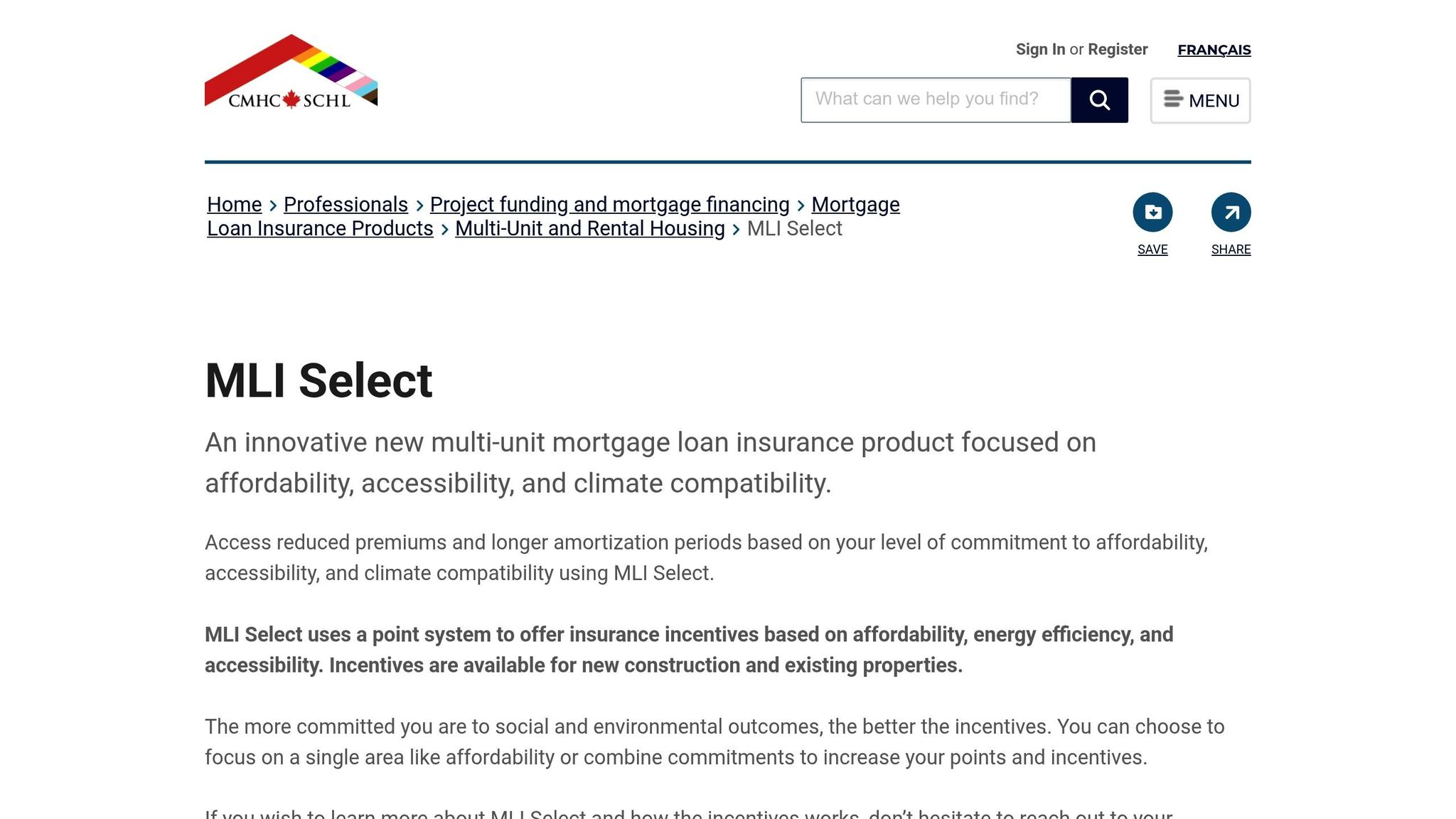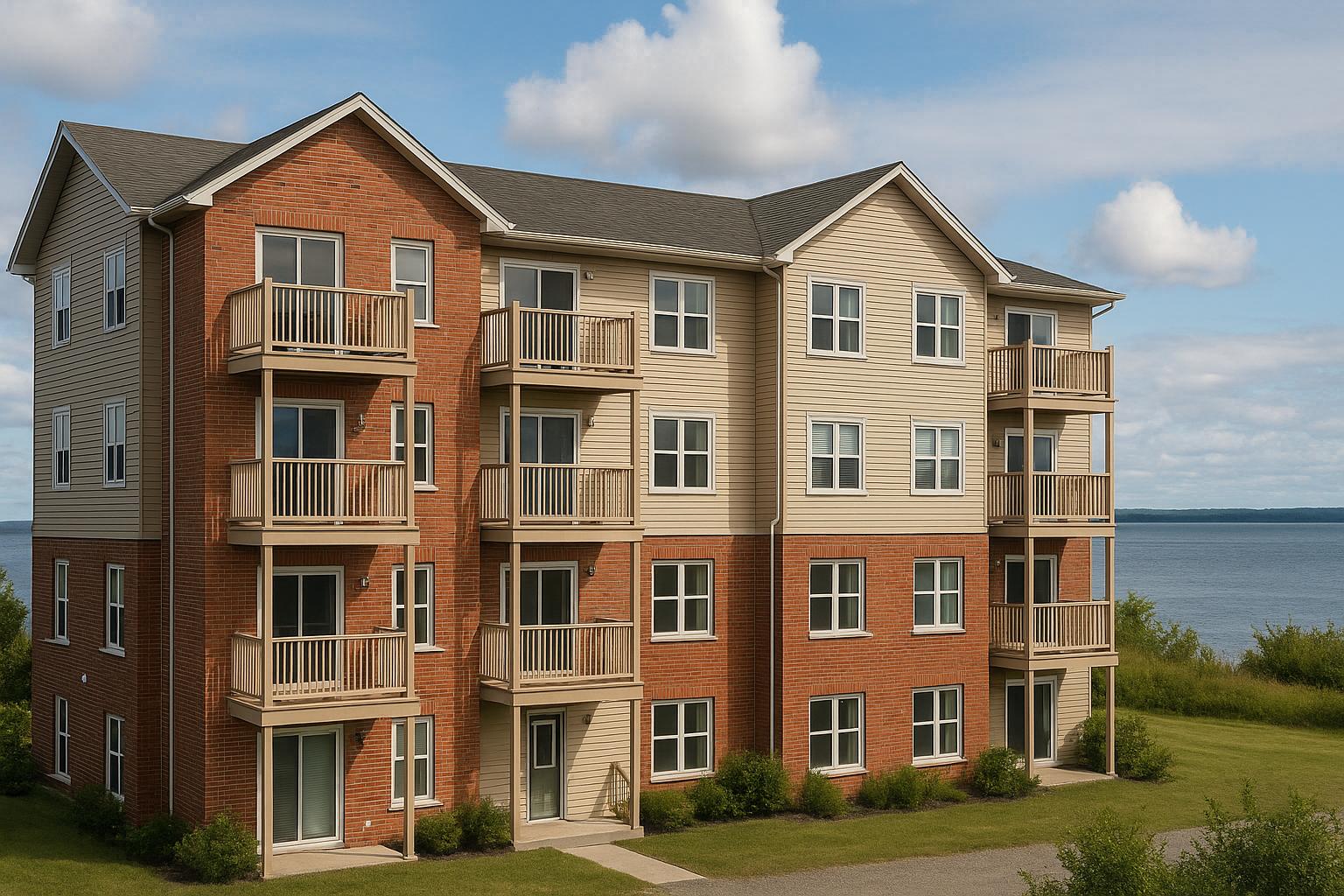The ER-3 energy model is designed to help small multi-unit rental buildings (4 to 24 units) achieve 20% energy savings compared to the NECB 2017 baseline. It’s a critical standard for developers aiming to lower operating costs, qualify for government incentives, and access financing options like CMHC MLI Select, which offers up to 95% financing and 50-year amortization periods.
Key Points:
- Lower Costs: Save on utility bills and boost rental profitability.
- Incentives: Compliance unlocks rebates and programs like Efficiency Nova Scotia.
- Design Requirements: Triple-pane windows, ductless heat pumps, energy recovery ventilation, and high-performance insulation are essential.
- Streamlined Process: Early collaboration with Energy Advisors ensures compliance and avoids delays.
- Financial Benefits: Higher ROI through reduced expenses, better tenant retention, and attractive financing terms.
To succeed with ER-3, developers must integrate energy efficiency from the design phase, use fixed-price contracts to ensure accountability, and align with financing requirements early.
Key Criteria Reviewers Assess for ER-3 Compliance
Documentation and Verification Process
Achieving ER-3 compliance hinges on providing clear, documented proof that energy-saving measures meet the 20% target. Reviewers look for a comprehensive energy efficiency report confirming that all energy-using systems align with Canadian standards. Products must also display an SCC-accredited verification mark to meet these requirements [1].
For imported goods, shipments must include all necessary data to verify compliance. Natural Resources Canada (NRCan) evaluates these reports to confirm that the products meet the required standards. Once approved, compliant models are added to NRCan's searchable product database [1].
This thorough documentation process is essential for Energy Advisors, helping them verify compliance efficiently and simplify the approval workflow.
Design Features and Practices for ER-3 Success
Common Features of ER-3-Compliant Buildings
Achieving ER-3 compliance requires incorporating specific design elements aimed at maximizing energy efficiency. Successful buildings typically integrate advanced systems and materials to meet the rigorous standards set by reviewers.
Triple-pane windows are a standout feature in ER-3-compliant designs. These windows provide much better thermal performance compared to double-pane alternatives, significantly reducing heat loss during Nova Scotia's harsh winters. Their ability to deliver measurable energy savings makes them a go-to option for meeting compliance standards.
Ductless heat pumps installed individually for each unit are another preferred choice in multi-unit buildings. Unlike traditional forced-air systems, these heat pumps offer precise temperature control while consuming less energy. They also empower tenants to manage their heating costs, contributing to the overall energy efficiency of the building.
Enhanced building envelope performance is another critical factor. This includes continuous insulation to minimize thermal bridging, advanced air sealing techniques, and the use of vapour barriers. Reviewers often look for designs that exceed minimum R-value requirements for walls, roofs, and foundations, ensuring superior thermal efficiency.
Energy recovery ventilation (ERV) systems are also commonly found in ER-3-compliant buildings. These systems capture heat from outgoing air and use it to preheat incoming fresh air, reducing the heating load while maintaining good indoor air quality.
Integrated Design-Build Approach
Fragmented construction can make ER-3 compliance challenging, as coordination issues between trades often lead to inefficiencies or compromises in energy performance. A better solution? The integrated design-build approach.
This method brings all team members together with a shared focus on meeting ER-3 standards from the very start. By embedding energy efficiency into the design process, rather than treating it as an afterthought, this approach ensures better overall performance and cost management.
The advantages of integration become particularly clear during the mechanical and electrical rough-in stages. For example, in traditional construction, HVAC installations might disrupt insulation or create thermal bridges. But with all trades working together under a unified energy plan, these issues can be avoided.
Fixed-price contracts are another key to success in ER-3 projects. By locking in costs upfront, these contracts remove the temptation to cut corners on energy efficiency measures. Precise scheduling ensures that critical tasks like air sealing and insulation are completed in the proper sequence, avoiding the performance gaps that can jeopardize compliance. This level of coordination helps streamline the entire process, from construction to final verification.
Case Study: Successful ER-3 Designs
A recent Halifax fourplex serves as a prime example of how an integrated design-build approach can drive ER-3 success. The project achieved a 23% improvement in energy efficiency, surpassing the required target.
Key features of the design included triple-pane windows, ductless heat pumps for individual temperature control, and continuous insulation to eliminate thermal bridging. The building envelope also exceeded standard R-value requirements for both walls and roofs.
Despite incorporating these advanced energy measures, the project was completed within six months. The integrated approach ensured seamless coordination between mechanical, electrical, and insulation teams, avoiding the delays often caused by disjointed workflows.
From a financial perspective, the strategy paid off. Units were rented at approximately $2,050 per month, benefiting from reduced utility costs and qualifying for CMHC MLI Select financing, which provided 95% financing over 50 years.
Energy performance verification went smoothly, thanks to consistent alignment between the energy model and the actual construction. This reduced the need for rework and secured timely approval from reviewers. The project highlights how integrating design and fixed-price contracts can lead to both energy efficiency and financial success.
This case demonstrates the value of treating energy efficiency as an integral part of the design process. Every decision, from foundation details to roof assembly, contributed to a unified energy strategy that delivered measurable performance and economic benefits.
How to Streamline ER-3 Compliance for Property Owners
Step-by-Step Compliance Guide
Start planning for energy efficiency right from the design phase. This proactive approach can save time, money, and headaches down the road.
- Collaborate early: Work closely with your energy consultant and architect to set clear performance goals before finalizing any drawings. This helps avoid costly redesigns later if compliance issues are identified.
- Submit a detailed energy model: Include an energy model with your building permit application. Make sure it provides complete details on insulation, windows, and mechanical systems. Nova Scotia reviewers require precise calculations to confirm your building meets energy performance standards. Missing details can lead to approval delays.
- Schedule inspections during key phases: Plan energy verification inspections at critical construction milestones, like after rough framing, insulation installation, and mechanical rough-ins. These inspections ensure your build stays aligned with the energy model.
- Conduct blower door testing: Before occupancy, schedule blower door testing to confirm your building envelope performs as expected. Booking this test well in advance allows time to address any issues without delaying your occupancy.
By weaving these steps into your construction timeline, you can avoid unnecessary delays and ensure a smoother path to receiving your occupancy permit. These processes also pave the way for adopting fixed-price contracts and unified project accountability.
The Role of Fixed-Price Contracts and Single Accountability
Traditional construction methods often lead to challenges in meeting ER-3 compliance because responsibilities for energy performance are divided among various contractors. This fragmented approach can create coordination issues that derail your energy targets.
- Fixed-price contracts simplify accountability: These contracts lock in costs and assign full responsibility for energy performance to a single entity. This eliminates coordination gaps and ensures all trades meet energy targets, keeping your project on track.
- Professional oversight ensures quality: When professional engineers oversee each stage of construction, they ensure that every trade contributes effectively to the building’s overall energy performance. This reduces the risk of costly fixes during final inspections.
By combining cost control with a single point of accountability, your project is better prepared to meet both compliance and financing requirements.
Aligning with CMHC MLI Select Financing

Meeting ER-3 compliance doesn’t just help with energy efficiency - it can also open the door to attractive financing options through the CMHC MLI Select program. This program offers benefits like up to 95% financing and a 50-year amortization period.
- Exceeding code requirements: To qualify, your project needs to achieve energy performance roughly 40% above standard building codes. This requires a superior building envelope, efficient mechanical systems, and airtight construction. Your energy consultant’s calculations will be critical for the financing application.
- Third-party verification: CMHC requires rigorous verification to ensure your construction aligns with the energy model. An integrated team that understands these requirements from the start is better equipped to avoid compliance issues that could jeopardize financing.
- Financial advantages: With just a 5% down payment and improved cash flow, this financing option makes energy-efficient projects a smart investment. Many property owners who qualify for MLI Select financing report annual returns of 12–20%, making ER-3 compliance a financially sound choice.
sbb-itb-16b8a48
Using the Performance Path for Energy Code Compliance
How to Maximize ROI with ER-3 Energy Efficiency
Building on earlier discussions about energy efficiency and compliance strategies, ER-3 construction offers property owners a pathway to maximize their return on investment (ROI).
Financial Advantages of Energy Efficiency
ER-3 buildings are designed to reduce operating costs while increasing rental income. For example, two-bedroom ER-3 rentals typically generate $1,950–$2,100 per month, offering property owners both steady revenue and lower vacancy rates due to their energy-efficient features. These properties also tend to appreciate over time, making them a solid long-term investment.
Beyond rental income, the advanced energy performance of ER-3 buildings enhances tenant satisfaction, which translates to reduced turnover and vacancy. Additionally, lower maintenance costs - particularly for mechanical systems - help strengthen cash flow over time. These financial perks also pave the way for better financing opportunities, further boosting ROI.
Qualifying for Incentive Programs with ER-3 Compliance
Meeting ER-3 standards can open the door to incentive programs like CMHC's MLI Select. ER-3-compliant buildings, which are engineered to be approximately 40% more energy efficient than standard code requirements, offer significant financing benefits:
- Lower down payments: Properties that meet ER-3 standards may qualify for up to 95% financing, requiring as little as a 5% down payment instead of the usual 20%.
- Longer amortization periods: Financing terms can extend up to 50 years, making monthly mortgage payments more manageable even with larger loan amounts.
- Simplified approval process: Lenders view energy-efficient buildings as lower-risk investments, which can expedite project approvals and help bring properties to market faster.
These advantages, combined with streamlined project teams that reduce compliance risks, create strong financial leverage for property owners. The benefits become even clearer when comparing the costs of standard and ER-3-compliant builds.
Standard vs. ER-3-Compliant Builds: A Cost Comparison
The table below highlights the differences between a conventional project and an ER-3-compliant build that takes full advantage of CMHC MLI Select financing:
| Investment Factor | Standard Construction | ER-3 Compliant (CMHC MLI Select) |
|---|---|---|
| Construction Cost per Unit | ≈$160,000 | ≈$200,000 |
| Down Payment | 20% (~$128,000 for 4 units) | 5% (~$40,000 for 4 units) |
| Financing Leverage | 5:1 | 20:1 |
| Mortgage Amortization | 25 years | 50 years |
| Expected Rent per Unit | $1,950–2,100/month | $1,950–2,100/month |
| Effective ROI | Market-dependent returns | Higher cash flow, better ROI |
While ER-3 construction involves higher upfront costs per unit, the financing benefits - like reduced down payments and extended amortization - free up capital and lower monthly mortgage payments. This improved cash flow not only covers operating expenses but also positions property owners to reinvest in additional properties, accelerating long-term wealth growth.
Key Takeaways for Property Owners
Why ER-3 Compliance is a Smart Investment
Meeting ER-3 standards isn't just about energy efficiency - it’s a move that can significantly boost your return on investment. For starters, property owners in provinces like Nova Scotia can access rebates of up to CA$500,000 for energy upgrades on commercial buildings [2]. These incentives, paired with energy savings, make ER-3 compliance a win-win for your bottom line.
Beyond the financial perks, green buildings have a lot going for them. They tend to lower operating costs, keep tenants happy, and increase in value over time. And when paired with CMHC MLI Select financing, which offers 95% financing with a 50-year amortization, property owners can stretch their capital further. For example, this financing can shift your capital efficiency from the usual 5:1 leverage to a game-changing 20:1 ratio.
Properties that go beyond the baseline energy code - achieving up to 40% greater energy efficiency - stand out in the market. These high-performing buildings often attract reliable tenants, command higher rents, and deliver consistent returns year after year.
Next Steps for Property Owners
To make the most of these financial and operational benefits, it’s crucial to take the right steps from the start. A proactive approach, paired with clear accountability, can ensure your project capitalizes on ER-3 compliance from design to completion.
- Choose an integrated design-build team: This approach simplifies project management and keeps everyone on the same page. To avoid delays, secure fixed-price contracts that include penalties for late completion (e.g., CA$1,000 per day).
- Check CMHC MLI Select eligibility early: With only a 5% down payment required - compared to the typical 20% - this financing frees up funds for other investments. Plus, the extended amortization period can greatly improve your monthly cash flow.
- Tap into local rebates: If you’re in Nova Scotia, explore rebate programs right away to offset upfront costs and make your project even more cost-effective.
FAQs
How can property owners ensure their small multi-unit projects meet ER-3 energy standards during the design phase?
To meet ER-3 energy standards, property owners should begin by collecting detailed information about the building's envelope, HVAC systems, and renewable energy options. This data lays the foundation for precise energy modelling, which identifies areas for improvement and ensures the design aligns with ER-3 requirements. Leveraging energy simulation tools early in the planning process can pinpoint potential tweaks to boost efficiency.
Teamwork plays a big role here - bring architects, engineers, and contractors on board from the start to embrace an integrated construction approach. This ensures that energy-efficient elements like advanced insulation, high-performance windows, and efficient HVAC systems are seamlessly incorporated into the design. Planning for renewable energy sources, such as solar panels, during the early stages can further enhance energy savings and simplify compliance. By addressing these factors upfront, property owners can sidestep delays, improve their return on investment, and qualify for financing programs like CMHC MLI Select.
How does a fixed-price contract and integrated design-build approach ensure the success of ER-3 energy model projects for small multi-unit properties?
A fixed-price contract paired with an integrated design-build approach plays a crucial role in the success of ER-3 energy model projects. These methods give property owners the advantage of cost predictability and smooth coordination throughout the entire project. By eliminating the uncertainties and delays that often arise from disjointed construction processes, this approach helps meet strict energy efficiency standards more effectively.
With design and construction managed by a single team, the integrated approach ensures the ER-3 energy model is applied accurately and evaluated efficiently. This not only speeds up the approval process but also allows property owners in Nova Scotia to optimize their return on investment (ROI) and access benefits like CMHC MLI Select financing. In the end, this approach minimizes risks, saves valuable time, and simplifies adherence to energy efficiency requirements.
What are the financial advantages of meeting ER-3 standards, and how does it help with CMHC MLI Select financing?
Meeting ER-3 energy efficiency standards comes with some solid financial perks for small multi-unit rental developments. These include reduced mortgage insurance premiums, longer amortization periods, and better cash flow. All of this helps property owners cut down on monthly costs.
On top of that, the CMHC MLI Select program offers attractive rewards for energy-efficient projects. These benefits include higher loan-to-value ratios, extended amortization terms, and lower premiums. Together, these incentives make it easier - and more affordable - to finance projects, boosting both their profitability and long-term feasibility.



